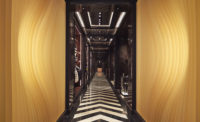When Maria Cunha, one of the three founding partners of the fledgling women’s shoe company Josefinas, contacted New York–based designer Christian Lahoude to create a flagship store in Manhattan, she thought he would pass. The company had purveyed their brand online only. This would be Josefinas’s first brick-and-mortar presence, with a significantly limited budget compared to Lahoude’s high-end clientele, which includes brands such as Jimmy Choo, Gucci, and Tiffany & Co. But after researching Josefinas’s merchandise, Lahoude knew that he wanted to be involved. “There was something there,” he says, “superior craftsmanship and quite luxurious qualities.”
Additional Content:
Jump to credits & specifications
After Cunha and cofounder Sofia Oliveira scouted a number of potential locations throughout the city, they settled on a long, narrow 540-square-foot storefront on a boutique-lined block in the NoLita neighborhood.
The challenge of translating the label’s digital identity into its first physical setting offered Lahoude an opportunity for creative freedom. “I really had a blank slate,” he says. “There was no precedent, no hundred years of history.”
Conceived in 2013 as a business run by women for women, Josefinas’s partners were brought together through a network of entrepreneurs in Portugal. “When we started, we didn’t have any money, we didn’t know anything about shoes,” says Oliveira. “But we wanted to create a brand that could empower women.” Since their first collection—a series of ballet slippers—Josefinas has grown to include over 40 different styles of flat shoes only, including a line endorsed by legendary feminist Gloria Steinem. “We don’t think that women need high heels to feel like a better version of themselves,” Oliveira says.
From the beginning, the three entrepreneurs knew that pink—the color of Josefinas’s shoeboxes and its signature ballet flat—had to be incorporated into the store design, but they didn’t want it to be “overly girly,” says Oliveira. “We wanted something that would embody a strong female character.”
“This brand isn’t about glitz or bling,” adds Lahoude, “so we tried to stay subtle.”
To soften up the space and minimize its linearity, Lahoude broke up the south wall by creating a series of curves that begins near the entrance with a sinuous cotton velvet sofa that flows to meet a concave alcove; there the collection is displayed (the space behind is used for storage). Opposite, a white brick wall lined with floating mirrored panels—some tinted a soft shade of peach—extends the length of the store to give an illusion of spaciousness while accentuating its ivory and coral pink hues. Concealed lighting below and above the mirrors lends an ethereal quality to the room.
The curvilinear surfaces also create a meandering circulation path through the store. According to Lahoude, evoking a journey was important to the Josefinas experience. Upon entering the shop, customers are introduced to a parlor-style setting: alongside the sofa and an accompanying lounge chair, a sparse array of shoes is presented on rosy copper stands. Just beyond, they discover the primary display of footwear, tucked into the arc of the recessed wall and arranged on lacquered semicircular shelves along its surface, which is textured with a mother-of-pearl wallcovering.
The copper reappears in the form of custom light fixtures and, most prominently, as a central artwork: a sculptural cast of a tree—made by a Portuguese artist, Jorge Direito—that encourages visitors to pause within the main display nook to peruse the collection. “The idea was to have a focal point—an organic element—that could be seen from the street, pulling people into the space,” says Lahoude. Because of the project’s budgetary constraints, a piece of curved plexiglass was placed above the sculpture in lieu of a light cove.
The path narrows to accommodate a closed employee area and restroom, only to open up again at the back of the store, revealing a “VIP area” articulated by a blush banquette, also cotton velvet, with views to a modestly furnished back garden. The journey culminates in this outdoor space, used as both an area of respite for customers and employees and an event venue.
According to Oliveira, the NoLita outpost, open for just over a year, operates as an extension of the online site. Since many of Josefinas’s shoes are custom-made for their patrons in Portugal, visitors to the boutique can place orders here but don’t necessarily walk out with their purchases. “We created an exclusive experience where the brand is made tangible,” she says.
Establishing the physical location has also proven to be a launchpad for new ideas: “We feel that the store could evolve into another concept, like a social club,” Oliveira says. “I imagine a mix of shoe shopping and conversations with other women.”
CreditsArchitect: Christian Lahoude Studio — Christian Lahoude, lead designer; Katharina Hoerath, project manager
Architect of Record: Steve Blatz
General contractor: KJ Remodeling
|
SpecificationsCarpet Scott Group Studio
Lighting Hera Lighting
Mirrors Capitol Glass & Sash
Wallcovering Altfield
Sofa Wood, Spring & Down |









